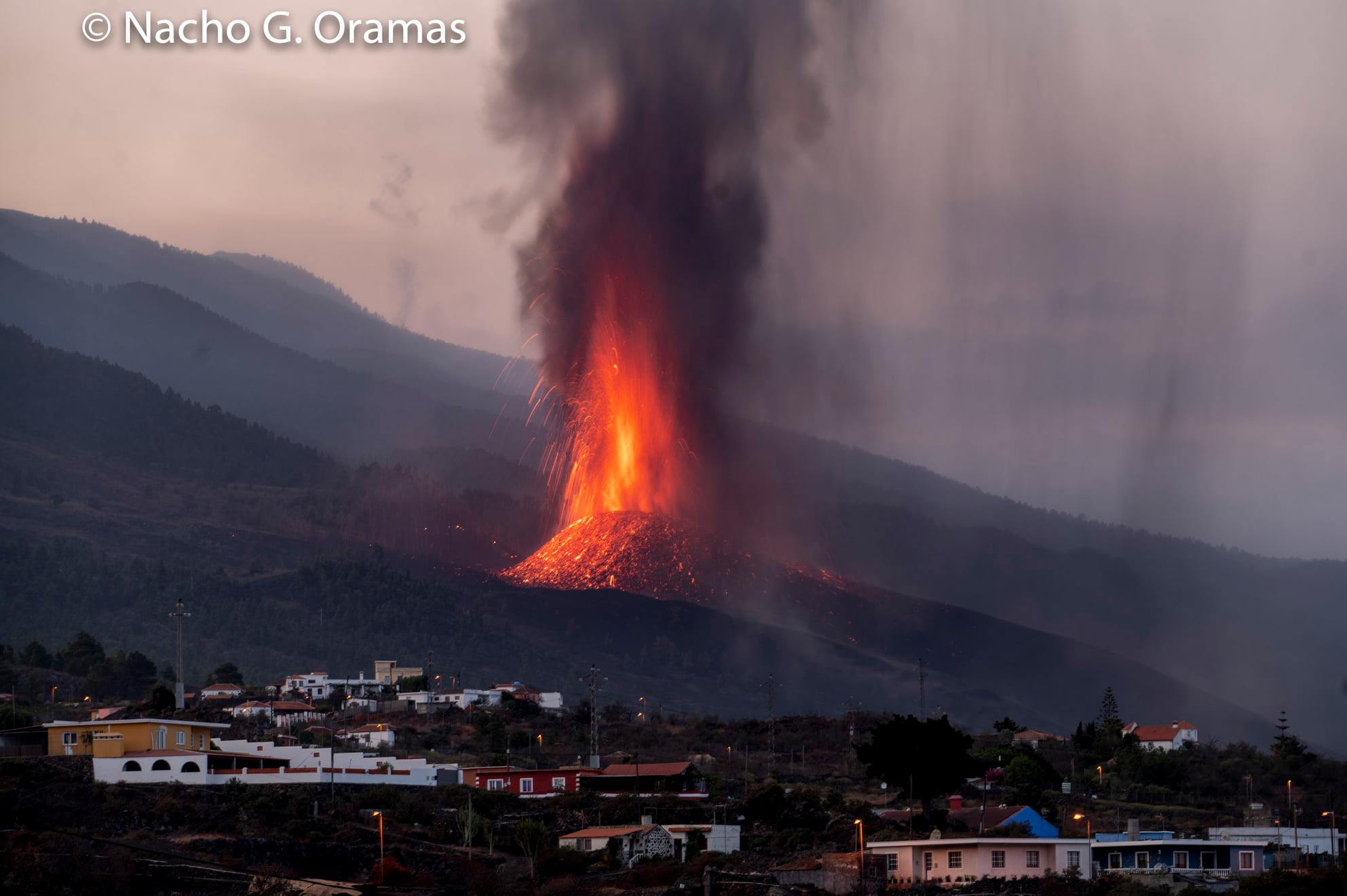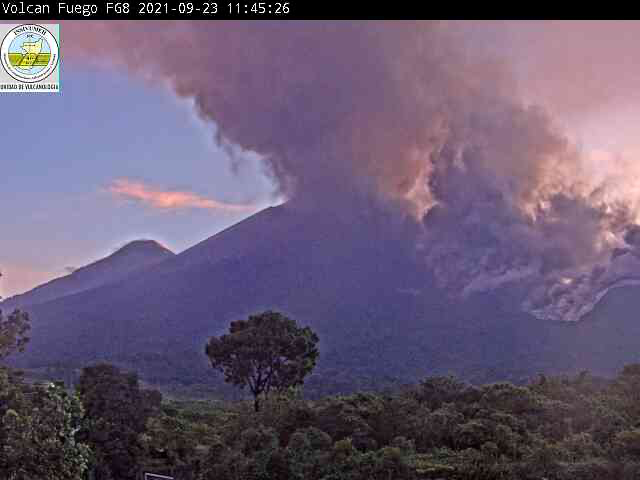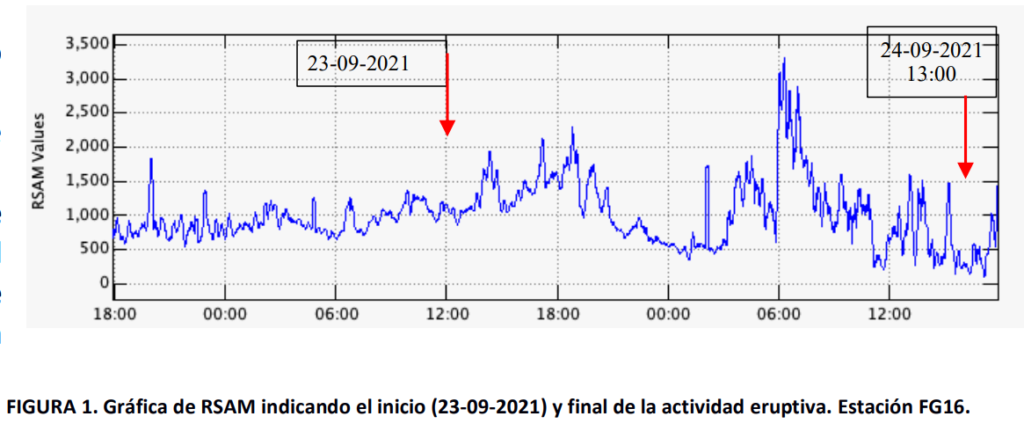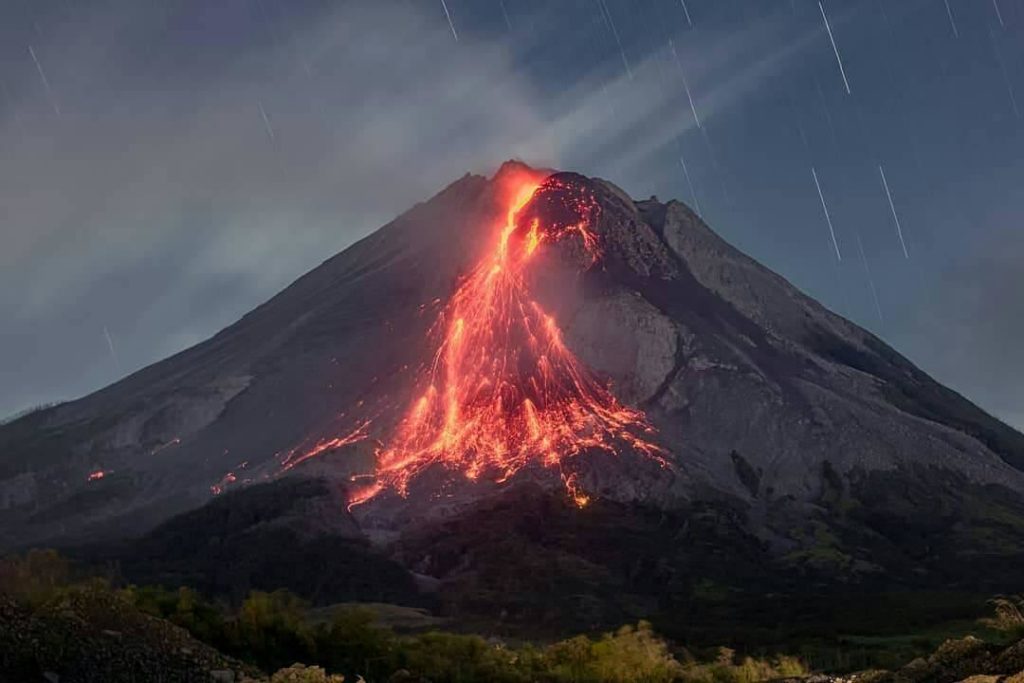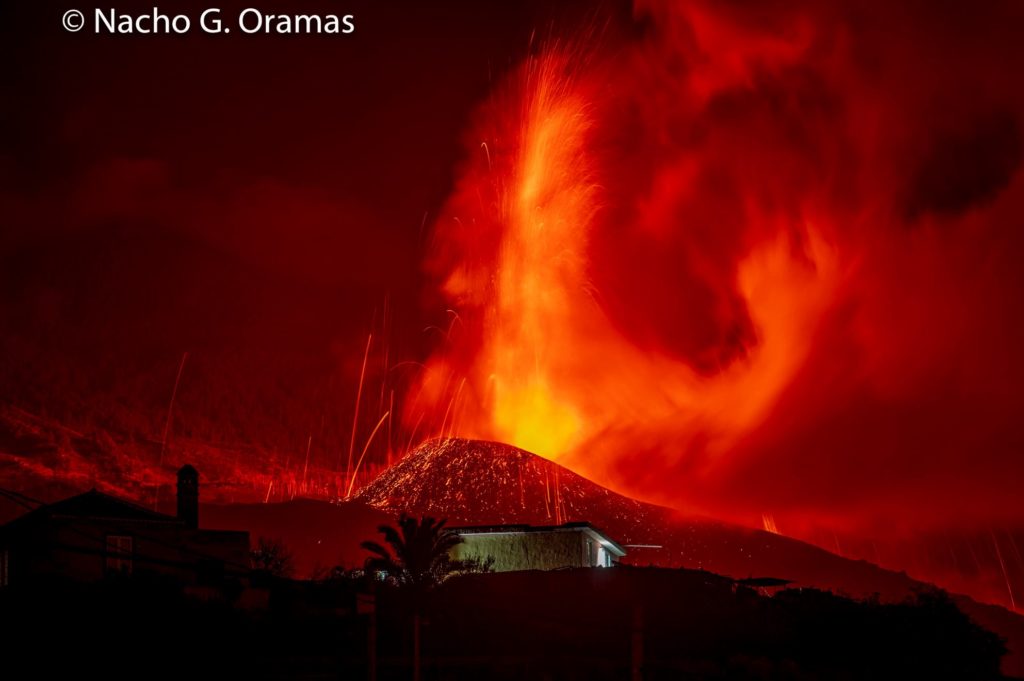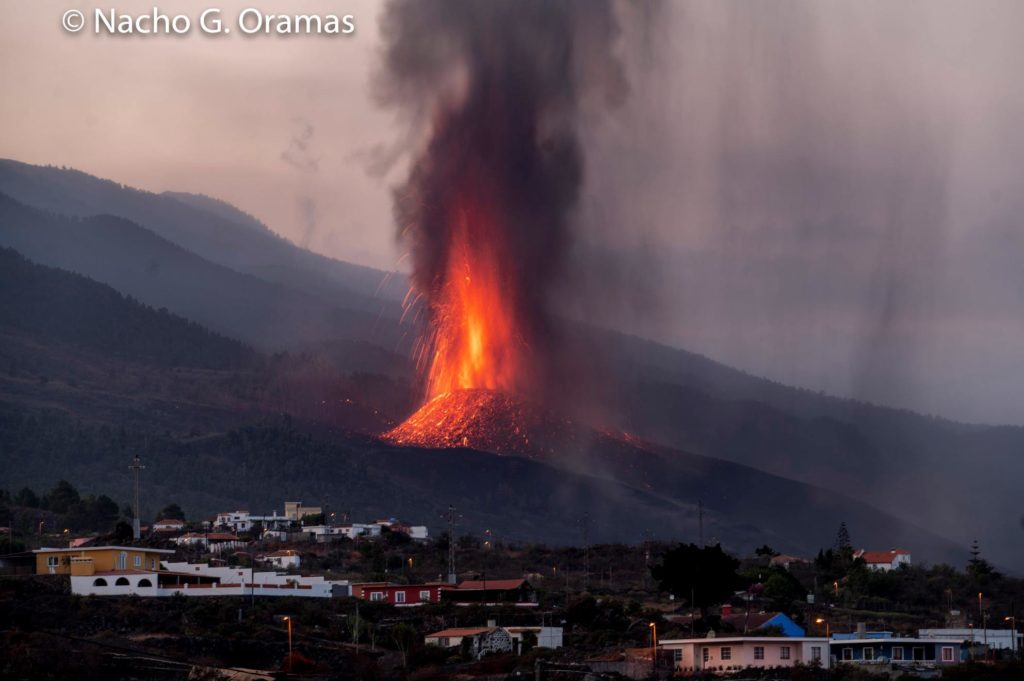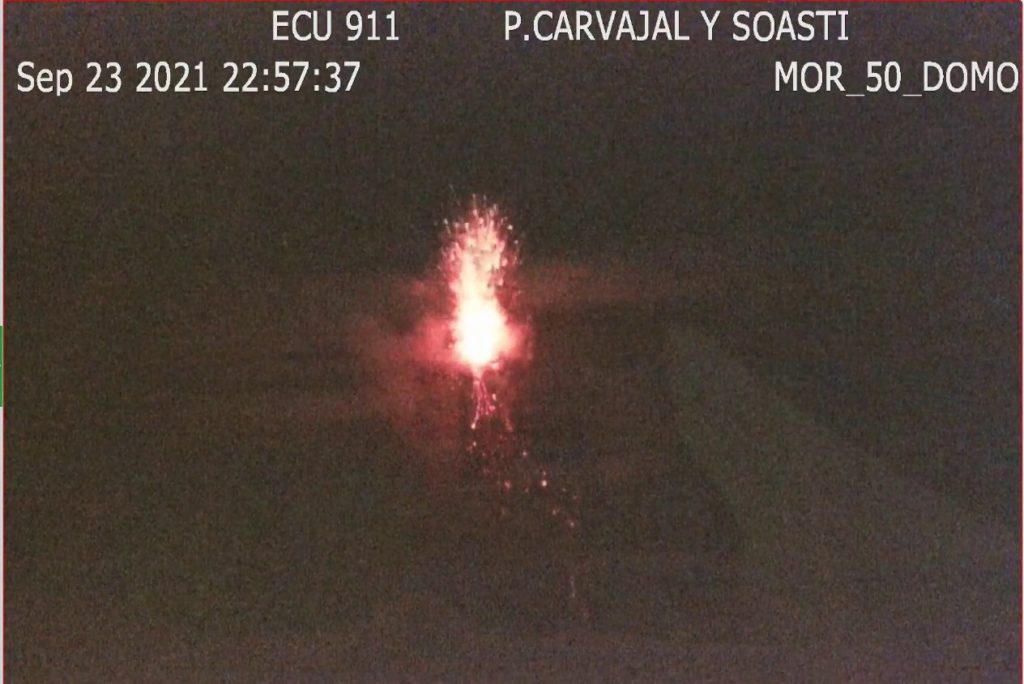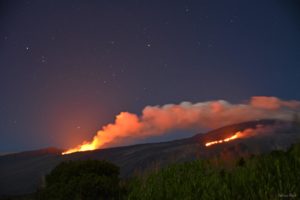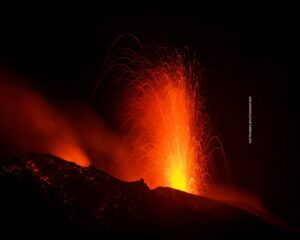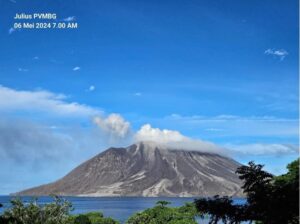September 25 , 2021.
Guatemala , Fuego :
ERUPTION
As reported in the special volcanological bulletin BEFGO-135-2021, the Fuego volcano has recorded an increase in its activity, producing lava flows in the canyons of Ceniza and Trinidad, which are accompanied by avalanches of incandescent boulders and ‘ weak to moderate shock waves. Currently, there is an increase in lava flow activity, producing the descent of moderate to heavy avalanches through the ravines of Ceniza, Trinidad, Taniluyá, Santa Teresa and Las Lajas. The detachment of incandescent blocks from these flows raises clouds of ash in the ravines already mentioned. Moderate to strong rumblings and shock waves are felt for at least 10 kilometers in all directions.
The activity that is recorded at this time corresponds to the start of an eruption of a Strombolian or mainly effusive nature, from which one can expect the advance of lava flows through several other ravines, causing the descent of strong avalanches in each of them, the expulsion of incandescent material from sources above the edge of the crater, explosions loaded with abundant ash, as well as the generation of pyroclastic flows in any ravine.
ERUPTION WITH DESCENT OF PYROCLASTIC FLOWS
As reported in the special volcanological bulletins BEFGO-135 and BEFGO-136-2021, the eruptive activity of the Fuego volcano can produce pyroclastic flows. At 5:40 am the descent of a pyroclastic flow is recorded in the ravine of Ceniza, which traveled between 4 and 6 kilometers until reaching the base of the volcano. These events may continue to occur as long as the outpouring of lava flows continues in this eruption. The cloud generated by this pyroclastic flow can cause ash falls in communities on the south and southwest flanks of the volcano, as well as affect air traffic in the surrounding area.
Activity: The Fuego volcano observatory reports 6 to 10 weak explosions per hour, which raise ash columns to heights of 4,500 to 4,700 meters (14,764 to 15,420 feet), which disperse westward and the Southwest. Since last night, it is possible to observe again the lava flow in the canyon of Ceniza, which reaches a length of 400 meters. The explosions and this lava flow produce moderate avalanches that descend almost constantly through the ravines of Ceniza, Trinidad, Santa Teresa and Las Lajas, some reaching the edge of the vegetation. This activity generates weak and some moderate rumblings with weak shock waves that vibrate the roofs and windows of the houses of the communities near the volcano. Noises of degassing are heard. The wind causes the ash to rise from the lava flow activity, creating a curtain of fine material in the upper part of the volcanic building and promoting ash fall in the communities of the West and South West Flanks.
SPECIAL VOLCANOLOGICAL BULLETIN # 144-2021
Following the eruption of the Fuego volcano and the BEFGO-143-2021 bulletin, the seismic and acoustic monitoring parameters and the field observations made by the OVFGO observers indicate that during the last hours this activity has remained in gradual decrease, which results in a low effusive activity, allowing the extrusion of magmatic material to decrease considerably and the lava flows to no longer remain active. Likewise, sounds similar to those of a train locomotive and an airplane turbine have diminished. The RSAM graph reflects the decrease in its seismic amplitude and its tendency to stay close to its baseline activity line. These changes suggest the completion of the eruptive activity of the Fuego volcano, which lasted a total of 32 hours.
INSIVUMEH maintains visual and instrumental monitoring of volcanic activity through seismic stations, volcano observers and web cameras.
Source et photos : Insivumeh.
Indonesia , Merapi :
Report on the activity of Mount Merapi from September 17 to 23, 2021
OBSERVATION RESULTS
Visual
The weather around Mount Merapi is generally sunny in the morning and evening, while it is foggy in the afternoon. We note white fumes, weak to thick, low pressure and 150 m high that were observed from the observation post of Mount Merapi de Selo on September 19, 2021 at 06:00 WIB. Lava avalanches were observed 141 times southwest with a maximum slide distance of 2000 m.
A slight morphological change was observed in the southwest lava dome. The volume of the southwest lava dome is 1,600,000 m3 and the central dome is 2,854,000 m3.
Seismicity
This week, the seismicity of Mount Merapi showed:
5 shallow volcanic earthquakes (VTB),
260 low frequency earthquakes s (LF),
251 times multi-phase earthquakes (MP),
1,357 Avalanche earthquakes (RF),
895 emission earthquakes (DG),
4 tectonic earthquakes (TT).
The intensity of this week’s seismicity is still quite high.
Deformation
The deformation of Mount Merapi which was monitored using EDM and GPS this week showed no significant changes.
Rain and lahars
This week, it rained at the Mount Merapi observation post with an intensity of 40 mm / hour for 50 minutes at the Ngepos post on September 21, 2021. There were no reports of lahars or additional flow in the mountains. rivers that take their source on Mount Merapi.
Conclusion
Based on the results of visual and instrumental observations, it is concluded that:
The volcanic activity of Mount Merapi is still quite high in the form of effusive eruption activity. The status of the activity is defined in the “SIAGA” level.
Source : Bpptkg.
Photo : @ilhamm_ska
Spain / La Palma , Cumbre Vieja :
PEVOLCA orders the containment of the population of Tajuya and Tacande de Abajo and the part of Tacande de Arriba which had not been evacuated before.
Tenerife firefighters are withdrawing from Todoque due to increased explosions and falling pyroclasts.
The PEVOLCA orders to evacuate the populations of Tajuya, Tacande de Arriba and Tacande de Abajo in the face of the explosion of the volcano of La Palma and the risk for the population in the face of increased emissions of pyroclasts and ash.
The General Directorate of Security and Emergencies of the Government of the Canaries, in application of the Pevolca, on Friday ordered the evacuation of the neighborhoods of Tajuya and Tacande – those which had not yet been evacuated – due to the intensification of the explosive activity at Cumbre Vieja.
In addition, the instability of the volcanic building has increased, the emitted materials can reach a greater distance and phenomena such as the influx of ash and volcanic material at high temperature can occur beyond the established area as exclusion zone.
Yesterday afternoon, the amplitude of the volcanic tremor recorded by the Canarian seismic network in La Palma increased until reaching its maximum around 4:00 p.m. (Canary Island time), then decreased very quickly, returning to background values for this eruption. This increase was linked to a strong increase in explosive activity of the Strombolian type which reached its maximum intensity in the afternoon since the start of the eruption on September 19. The figure shows the magnitude of the volcanic tremor recorded by the PMLU station during the last 5 days.
The eruption of the Cumbre Vieja volcano is still ongoing, with a very explosive phase since yesterday.
The ash cloud reaches nearly 6 kilometers in height.
A new eruptive mouth has opened and a new flow is being created which is sliding rapidly down the slope.
The Pevolca announces in its last report that the eruption continues to be of a fissural eruptive style, with a Strombolian mechanism. « We are confronted with a Strombolian eruption, with a low explosive index », explains the coordinator of Involcan. The characteristics of this volcano are that it has a low viscosity magma, with a high concentration of volatiles. These eruptions have eruptive columns that can reach 15 kilometers.
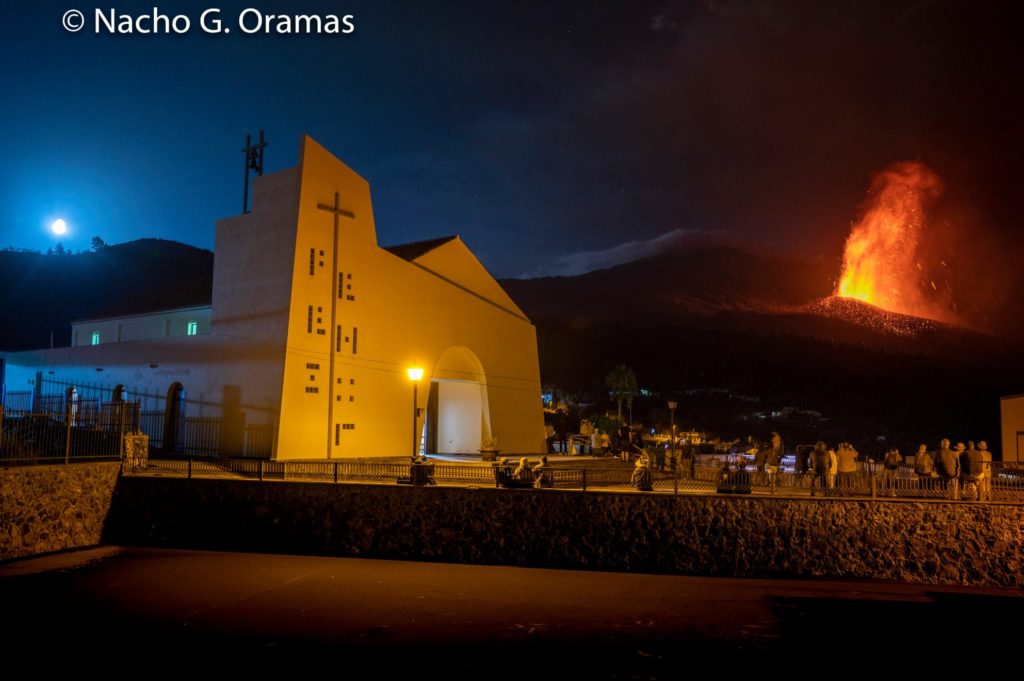
The ash cloud can be very harmful to the inhabitants. Consequently, the management of Prevolca ordered the evacuation of Tajuya, Tacande de Abajo and the part of Tacande de Arriba which had not yet been evacuated. The eruption of the volcano has already forced the eviction of 6,000 people on the island of La Palma. The inhabitants of La Palma are evacuated for three reasons: danger of gas, danger of ash and large rocks reaching the population, prevention in the event of the opening of the volcano’s cone and a powerful explosion or flows in the lower part of the slope. Residents of three El Paso neighborhoods were evacuated to the municipality’s soccer field after the volcano entered an extreme explosive phase.
One of the effects of the volcano eruption is ash. Itahiza Domínguez, seismologist at the National Geographical Institute, « Ashes are a major problem on highly explosive volcanoes because » houses can collapse due to their weight. « This is why they recommend expelling the ashes from the roofs, because 20 centimeters weighs like a meter of snow.
The National Geographic Institute has published on its social networks a new specific indicator of the eruption of the volcano La Palma. This meter calculates the amplitude of the tremor, directly linked to the explosiveness of the volcano and the quantity of magma that is released.
The Spanish airline has been forced to stop its flights. She made this decision because of force majeure, because in the last few hours the situation of suspended ash has worsened considerably. The shutdown of this service will last until conditions improve and allow theft, ensuring safety. The airline Vueling announced the cancellation of the flight Barcelona – La Palma scheduled for this Saturday at 13:50. The cause is the evolution of the ash cloud that affects Mazo airport.
The latest studies from the Copernicus agency, dedicated to Earth observation, ensure that the volcano has already destroyed approximately:
420 buildings
190 hectares
15.2 kilometers of roads.
Sources : Pevolca , diariodeavisos.elespanol.com . Involcan , Jaguar Del Sol .
Photos : Nacho g Oramas via Sherine France , Involcan
Alaska , Pavlof :
55°25’2″ N 161°53’37 » W,
Summit Elevation 8261 ft (2518 m)
Current Volcano Alert Level: WATCH
Current Aviation Color Code: ORANGE
Small ash emissions and explosions were detected in seismic and infrasound data at Pavlof on September 18, 19, 22, and 23. These ash producing explosions could be seen in web camera images and by local observers with ash clouds rising to several hundred meters above the summit and occasionally being pushed by wind down the flanks of the volcano. On other days elevated seismic tremor was detected but no explosions, and most web camera and satellite images were obscured by clouds.
The explosions that have occurred during Pavlof Volcano’s current period of activity have been short-lived, with ash deposits confined to the flanks of the volcano. Eruptive activity is focused at a vent on the upper southeast flank of the volcano, near the location of the eruptive vent in 2007. The level of unrest at Pavlof can change quickly and the progression to more significant eruptive activity can occur with little or no warning.
Pavlof Volcano is monitored by local seismic and infrasound sensors, satellite data, web cameras, and remote infrasound and lightning networks.
Pavlof Volcano is a snow- and ice-covered stratovolcano located on the southwestern end of the Alaska Peninsula about 953 km (592 mi) southwest of Anchorage. The volcano is about 7 km (4.4 mi) in diameter and has active vents on the north and east sides close to the summit. With over 40 historic eruptions, it is one of the most consistently active volcanoes in the Aleutian arc. Eruptive activity is generally characterized by sporadic Strombolian lava fountaining continuing for a several-month period. Ash plumes as high as 49,000 ft ASL have been generated by past eruptions of Pavlof, and during the March 2016 eruption, ash plumes as high as 40,000 feet above sea level were generated and the ash was tracked in satellite data as distant as eastern Canada. The nearest community, King Cove, is located 48 km (30 miles) to the southwest of Pavlof.
Source : AVO
Photo : Jacob, Ben David
Ecuador , Sangay :
DAILY REPORT ON THE STATE OF SANGAY VOLCANO.
Surface activity level: High, Surface trend: No change.
Internal activity level: High, Internal trend: No change.
Seismicity: From September 23, 2021, 11:00 a.m. to September 24, 2021, 11:00 a.m .:
Reference station data transmission problems prevent availability of seismic statistics
Emission column / ash:
In the images shared by the ECU911, several gas emissions were observed.
Rains / Lahars:
Rains with readings of up to 0.1 mm were recorded, as benchmark data from the Windy weather application.
Other monitoring parameters:
Thermal anomaly identification applications such as FIRMS recorded 17 thermal alerts; while MIROVA recorded 1 moderate thermal alert and 1 high thermal alert (142 MW) in the last 24 hours.
Observation:
Last night, good weather conditions in the region made it possible to identify, through images shared by ECU911, Strombolian activity as well as the expulsion of incandescent material which descended towards the south-eastern flank of the volcano.
Alert level: yellow.
Source et photo : IGEPN.

